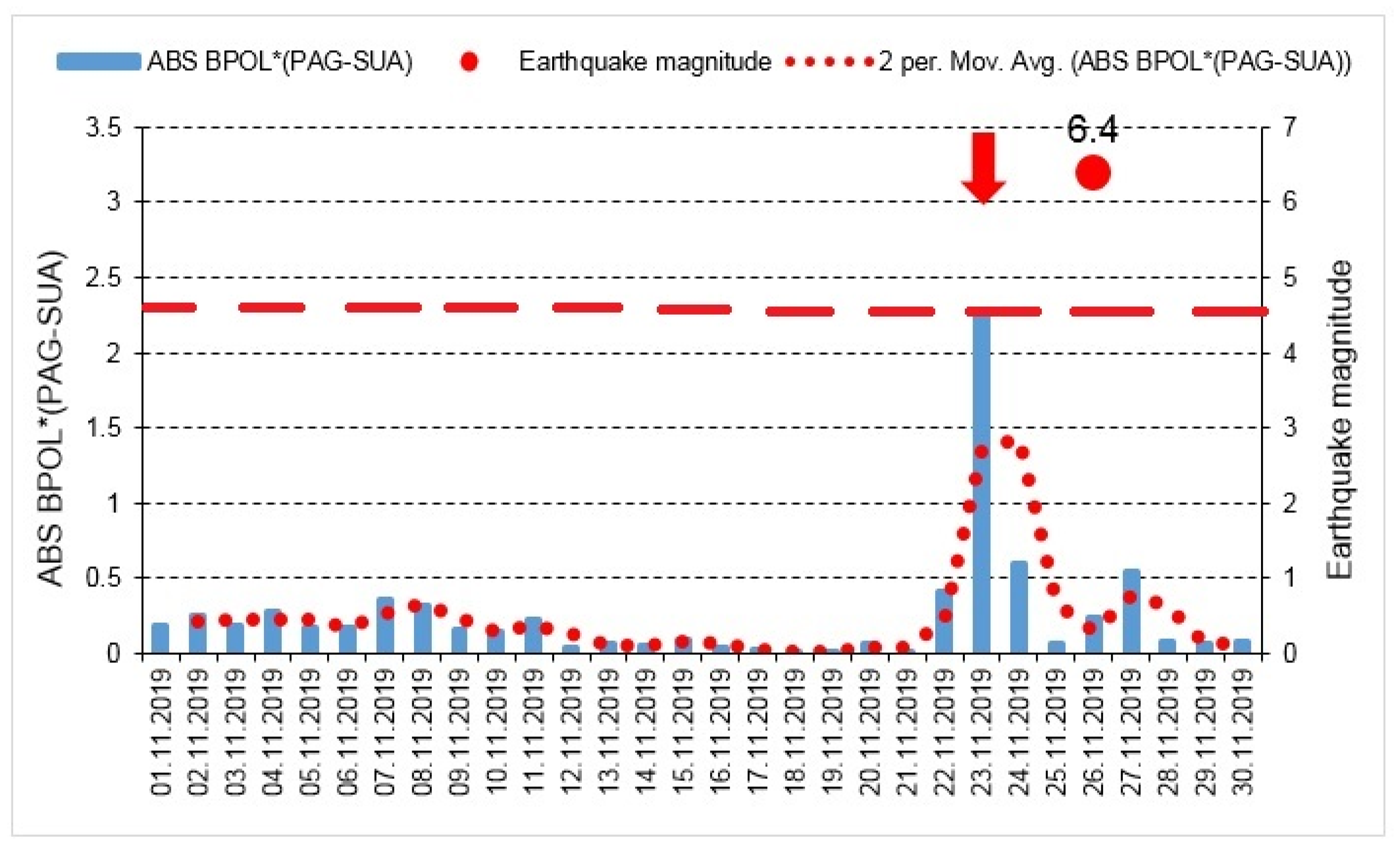Possible Correlations between the ULF Geomagnetic Signature and Mw6.4 Coastal Earthquake, Albania, on 26 November 2019
Abstract
1. Introduction
2. Material and Methods
Basic Theoretical Concepts
- (a)
- Polarization parameter (BPOL) expressed as:
- (b)
- Distance (R) between the observatories and earthquake epicenter is taken into consideration according to the Relation (2), given in [24]
- to identify geomagnetic precursory signal triggered by Mw6.4 earthquake, that may be observed in the both mentioned observatories, by means of the following relation:
- to separate the precursory seismic signals from the ionospheric and terrestrial geomagnetic field variations, taking PAG observatory as reference, according to the Relation (4):
3. Results
3.1. BPOL (PAG) and BPOL (SUA) Time Series Carried Out Using Relation (1)
3.2. BPOL* (PAG) and ABS BPOL* (PAG) Time Series Carried Out Using Relation (3)
3.3. ABS BPOL* (PAG-SUA) Time Series Carried Out Using Relation (4)
4. Discussion and Conclusions
- —
- The BPOL (PAG) and BPOL (SUA) time series obtained on the interval 1–30 November using (Relation 1), emphasize two pre-seismic anomalous signatures, extended on the intervals 21–27 November for PAG and 21–28 November for SUA, on which two maximum amplitudes were identified on 23 November (1.727 for PAG and 1.892 for SUA), with 3 days before the occurrence of Mw6.4earthquake. These results are presented in Section 3.1, Figure 4 and Figure 5;
- —
- A precursory signature associated to the above-mentioned earthquake was identified on the BPOL* (PAG) and ABS BPOL* (PAG) time series carried out on the interval 1–30 November, using a statistical analysis based on Relation 3, and the results are emphasized in Section 3.2, Figure 6 and Figure 7. On the both BPOL* (PAG) and ABS BPOL* (PAG) time series an anomalous interval, extended between 22 and 24 November, with a maximum value of 2.5 (Figure 6 and Figure 7), was identified with 3 days before the Mw6.4 earthquake occurrence.
Author Contributions
Funding
Acknowledgments
Conflicts of Interest
References
- Hayakawa, M.; Hobara, Y.; Yasuda, Y.; Yamaguchi, H.; Ohta, K.; Izutsu, J.; Nakamura, T. Possible precursor to the March 11, 2011, Japan Earthquake: Ionospheric perturbations as seen by subionospheric very low frequency/low frequency propagation. Ann. Geophys. 2012, 55, 95–99. [Google Scholar] [CrossRef]
- Nagao, T.; Orihara, Y.; Kamogawa, M. Precursory phenomena possibly related to the 2011 M9.0 off the Pacific coast of Tohoku earthquake. J. Disaster Res. 2014, 9, 303–310. [Google Scholar] [CrossRef]
- Ouzounov, D.; Pulinets, S.; Romanov, A.; Romanov, A.; Tsybulya, K.; Davidenko, D. Kafatos, M.; Taylor, P. Atmosphere-ionosphere response to the M9 Tohoku earthquake revealed by multi-instrument space-borne and ground observations: Preliminary results. Earthq. Sci. 2011, 24, 557–564. [Google Scholar] [CrossRef]
- Sarlis, N.; Skordas, E.; Varotsos, P.; Nagao, T.; Kamogawa, M.; Tanaka, H.; Uyeda, S. Minimum of the order parameter fluctuations of seismicity before major earthquake in Japan. Proc. Natl. Acad. Sci. USA 2013, 110, 13734–13738. [Google Scholar] [CrossRef] [PubMed]
- Hayakawa, M.; Schekotov, A.; Potirakis, S.; Eftaxias, K. Criticality features in ULF magnetic field prior to the 2011 Tohoku earthquake. Proc. Jpn. Acad. Ser. B 2015, 91, 25–30. [Google Scholar] [CrossRef] [PubMed]
- Stanica, D.A.; Stanica, D.; Vladimirescu, N. Long-range anomalous electromagnetic effect related to M9 Great Tohoku earthquake. Earth Sci. 2015, 4, 31–38. [Google Scholar]
- Stanica, D.A.; Stanica, D.; Blecki, J.; Ernst, T.; Jozwiak, W.; Slominski, J. Pre-seismic geomagnetic and ionosphere signatures related to the Mw5.7 earthquake occurred in Vrancea zone on September 24, 2016. Acta Geophys. 2018, 66, 167–177. [Google Scholar] [CrossRef]
- Stanica, D.A.; Stanica, D. ULF pre-seismic geomagnetic anomalous signal related to Mw8.1 offshore Chiapas earthquake, Mexico on 8 September 2017. Entropy 2019, 21, 29. [Google Scholar] [CrossRef] [PubMed]
- Stanica, D.A.; Stanica, D. Geomagnetic anomalous signal associated with Mw8.3 Coquimbo-Chile earthquake on September 16th, 2015. In Proceedings of the GEOSCIENCE 2019, Bucharest, Romania, 22 November 2019. [Google Scholar]
- Stanica, D.A.; Stanica, D.; Valeca, M.; Iordache, Ș. Electromagnetic contribution to the resilience improvement against the Vrancea intermediate depth earthquakes, Romania. Ann. Geophys. 2020, 63, 551. [Google Scholar] [CrossRef]
- Petraki, E.; Nikolopoulos, D.; Nomicos, C.; Stonham, J.; Cantzos, D.; Yannakopoulos, P.; Kottou, S. Electromagnetic pre-earthquake precursors: Mechanisms, data and models—A review. J. Earth Sci. Clim. Change 2015, 6, 250. [Google Scholar] [CrossRef]
- Fitterman, D.V. Electrokinetic and magnetic anomalies associated with dilatant regions in a layered Earth. J. Geophys. Res. Solid Earth 1978, 83, 5923–5928. [Google Scholar] [CrossRef]
- Sasai, Y. Tectonomagnetic modeling on the basis of the linear piezomagnetic effect. Bull. Earthq. Res. Inst. Univ. Tokyo. 1991, 66, 585–722. [Google Scholar]
- Fitterman, D.V. Theory of electrokinetic-magnetic anomalies in a faulted half-space. J. Geophys. Res. Solid Earth 1979, 84, 6031–6040. [Google Scholar] [CrossRef]
- Varotsos, P.; Alexopoulos, K.; Nomicos, K.; Lazaridou, M. Earthquake prediction on electric signals. Nature 1986, 322, 120. [Google Scholar] [CrossRef]
- Ouzounov, D.; Pulinets, S.; Guiliani, G.; Velichkova-Istova, S.; Kafatos, M.; Taylor, P. Pre-Earthquake Processes Associated with the M6.4 of Nov 26, 2017 in Albania. A Multi Parameters Analysis. In Proceedings of the EGU General Assembly 2020, Online, 4–8 May 2020. [Google Scholar] [CrossRef]
- Colonna, R.; Tramutoli, V.; Filizzola, C.; Genzano, N.; Lisi, M.; Pergola, N. Statistical Analysis for the Identification of Precursory Signatures of Earthquake Occurrence in Total Electron Content (TEC). In Proceedings of the EGU General Assembly 2020, Online, 4–8 May 2020. [Google Scholar] [CrossRef]
- Contadakis, M.E.; Arabelos, D.; Vergos, G.; Scordilis, E.M. Lower Ionospheric Turbulence Variations during the Intense Seismic Activity of the Last Half of 2019 in the Broader Balkan Region. In Proceedings of the EGU General Assembly 2020, Online, 4–8 May 2020. [Google Scholar] [CrossRef]
- Biagi, P.F.; Nina, A.; Ermini, A.; Nico, G. Variations revealed by INFREP Radio Network in Correspondence of Six Earthquakes with MW Greater Than 5.0 Occurred in the Balkan Peninsula and Adriatic Sea on 26 and 27 November, 2019. In Proceedings of the EGU General Assembly 2020, Online, 4–8 May 2020. [Google Scholar] [CrossRef]
- Moldovan, I.A.; Toader, V.E.; Oikonomou, C.; Haralambous, H.; Biagi, P.F.; Muntean, A.; Mihai, A.; Khadka, A. Investigation of Pre-Earthquake Ionospheric Anomalies Before Albania 2019 Earthquake Using the Romanian Receivers of the Vlf/Lf Infrep and Gnss Global European Networks. In Proceedings of the EGU General Assembly 2020, Online, 4–8 May 2020. [Google Scholar] [CrossRef]
- Tramutoli, V.; Genzano, N.; Colonna, R.; Filizzola, C.; Lisi, M.; Pergola, N.; Satriano, V. Satellite Thermal Monitoring of Balkan Region by Means of Robust Satellite Techniques: The Case of Albania (26 November 2019, Mw 6.4) Earthquake. In Proceedings of the EGU General Assembly 2020, Online, 4–8 May 2020. [Google Scholar] [CrossRef]
- Schmid, M.S.; Fügenschuh, B.; Kounov, A.; Matenco, L.; Nievergelt, P.; Oberhänsli, R.; Pleuger, J.; Schefer, S.; Schuster, R.; Tomljenović, B.; et al. Tectonic units of the Alpine collision zone between Eastern Alps and western Turkey. Gondwana Res. 2020, 78, 308–374. [Google Scholar] [CrossRef]
- Hayakawa, M.; Kawate, R.; Molchanov, O.A.; Yumoto, K. Results of ultra-Low-frequency magnetic field measurements during the Guam earthquake of 8 August 1993. Geophys. Res. Lett. 1996, 23, 241–244. [Google Scholar] [CrossRef]
- Morgunov, V.; Malzev, S. A multiple fracture model of pre-seismic electromagnetic phenomena. Tectonophysics 2007, 431, 61–72. [Google Scholar] [CrossRef]
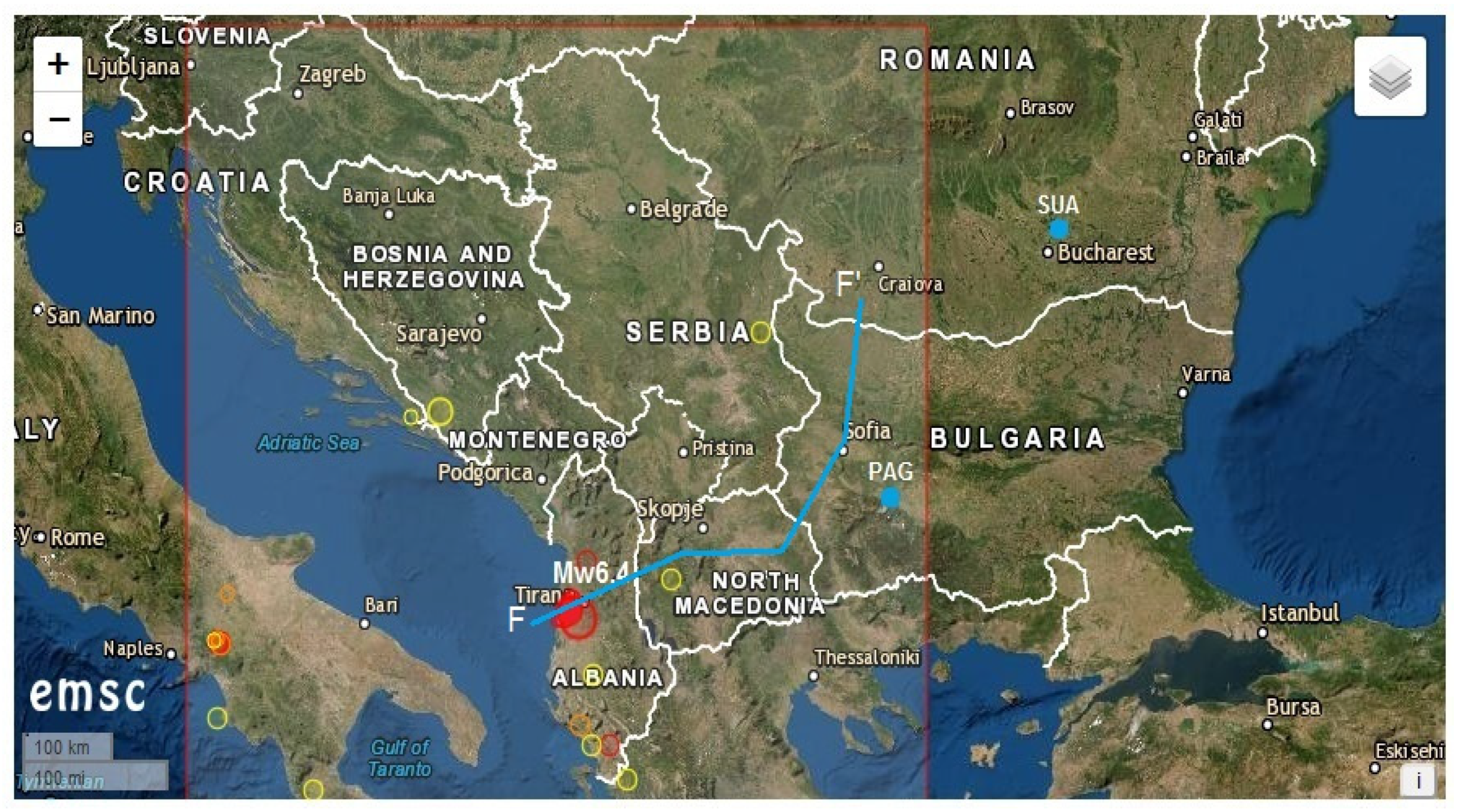
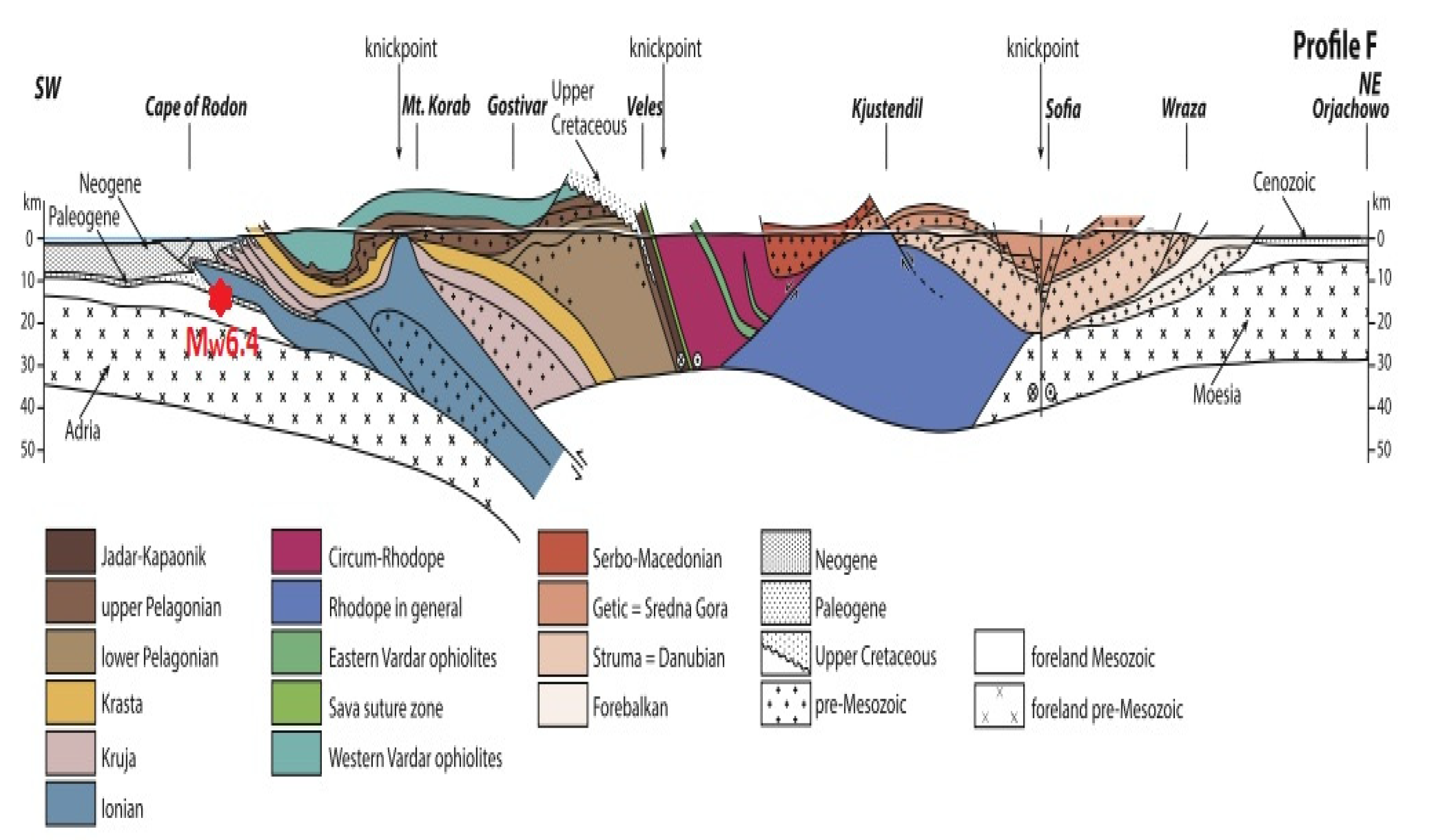
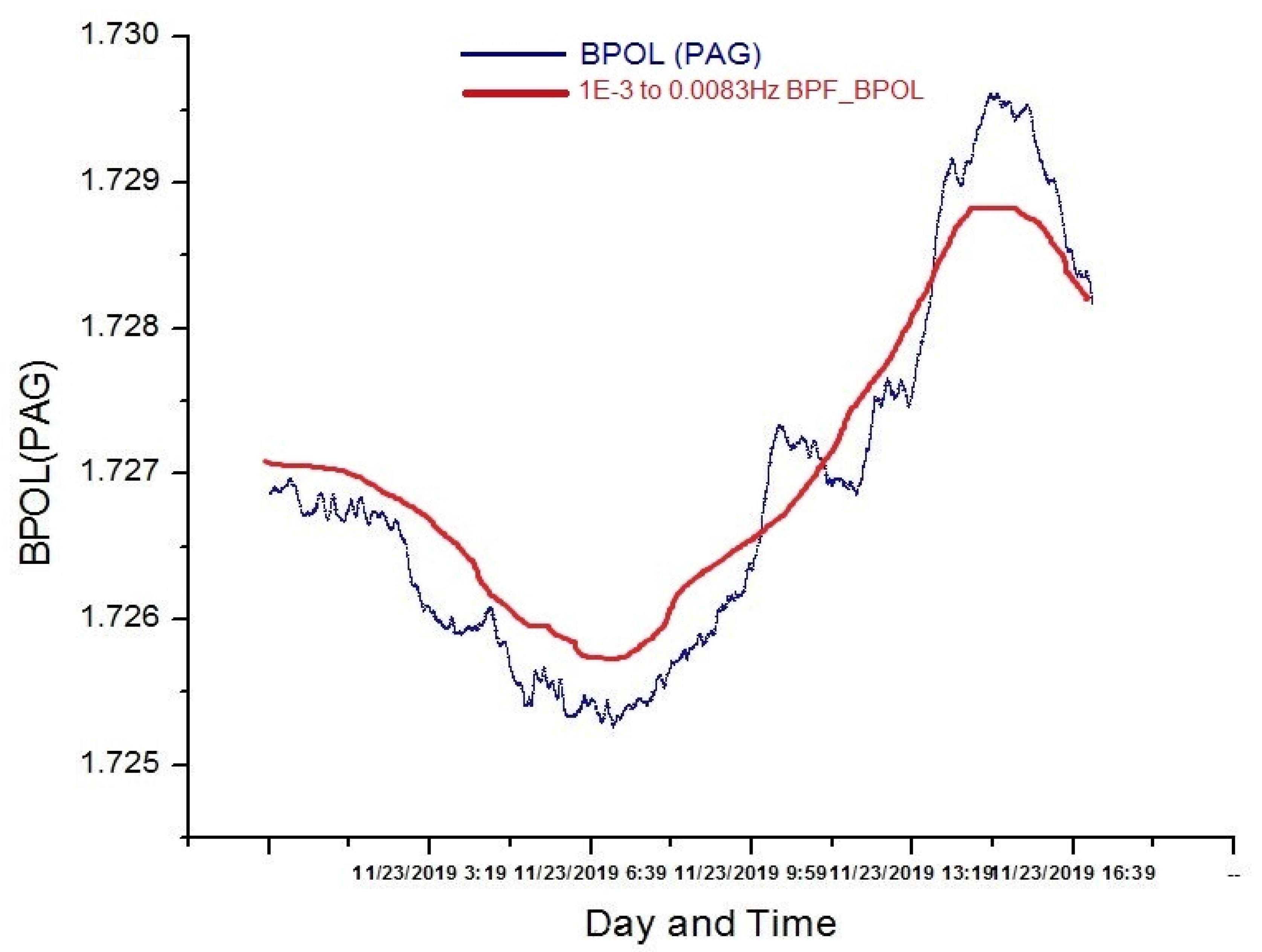
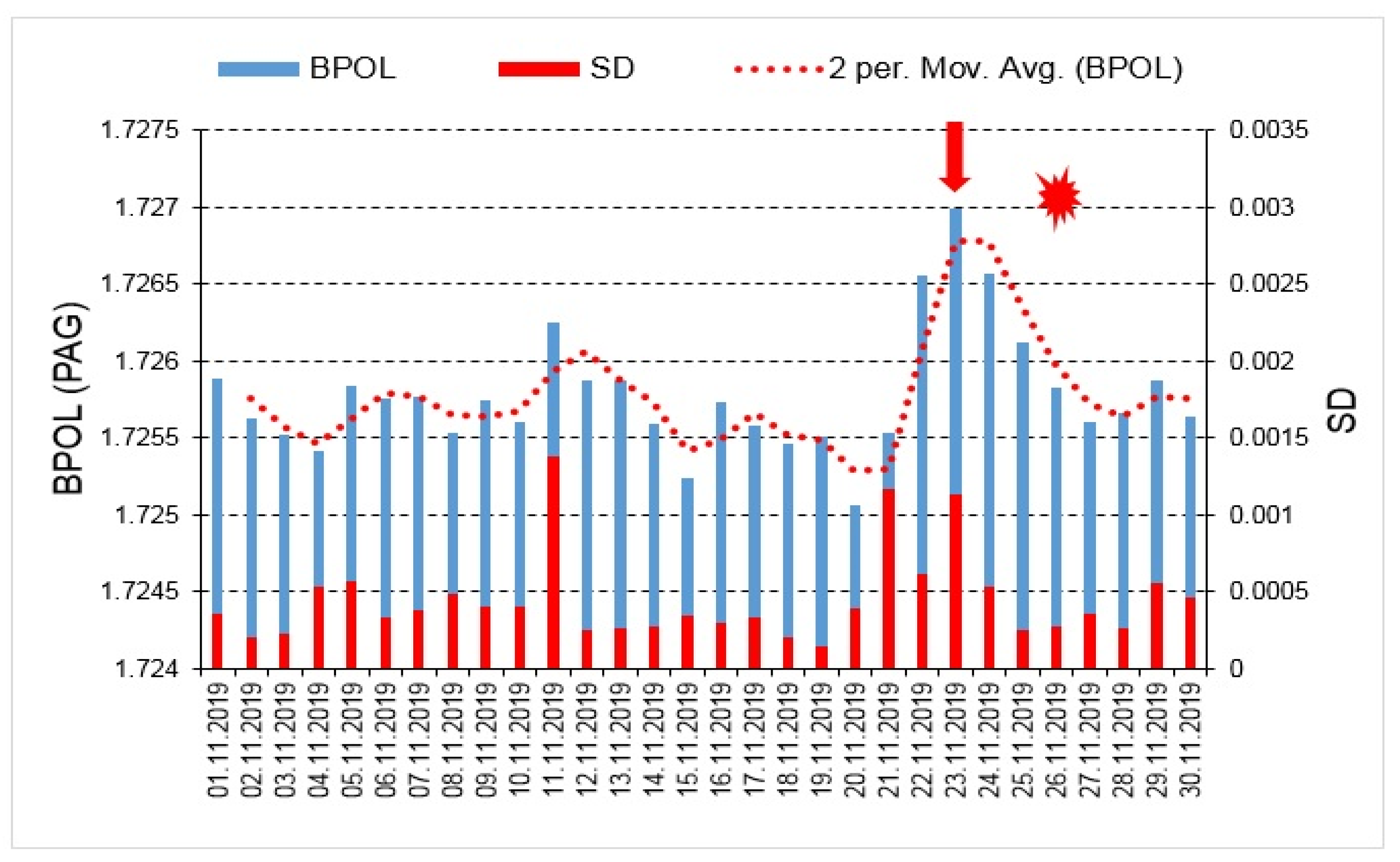

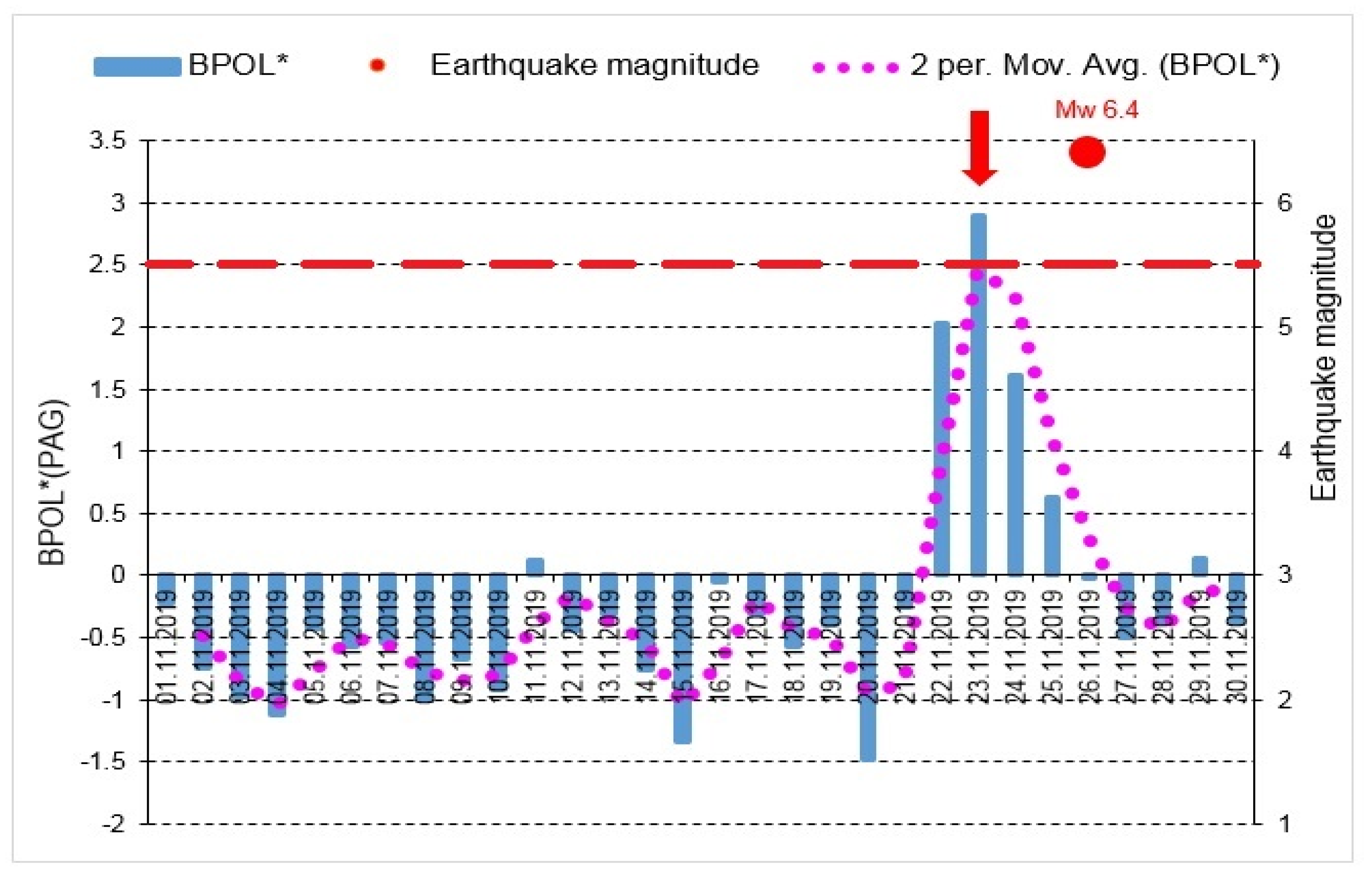
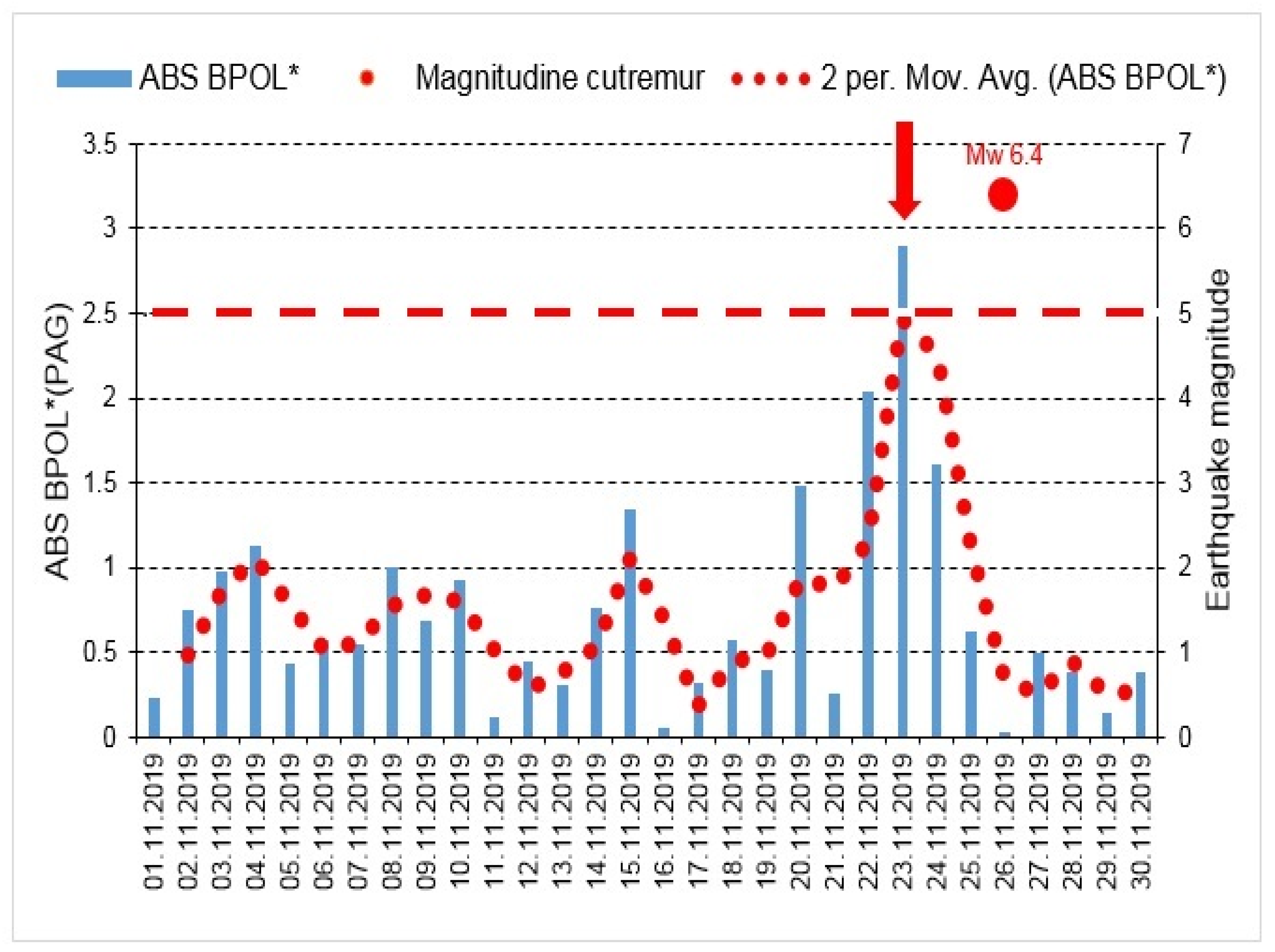
Publisher’s Note: MDPI stays neutral with regard to jurisdictional claims in published maps and institutional affiliations. |
© 2021 by the authors. Licensee MDPI, Basel, Switzerland. This article is an open access article distributed under the terms and conditions of the Creative Commons Attribution (CC BY) license (http://creativecommons.org/licenses/by/4.0/).
Share and Cite
Stănică, D.A.; Stănică, D. Possible Correlations between the ULF Geomagnetic Signature and Mw6.4 Coastal Earthquake, Albania, on 26 November 2019. Entropy 2021, 23, 233. https://doi.org/10.3390/e23020233
Stănică DA, Stănică D. Possible Correlations between the ULF Geomagnetic Signature and Mw6.4 Coastal Earthquake, Albania, on 26 November 2019. Entropy. 2021; 23(2):233. https://doi.org/10.3390/e23020233
Chicago/Turabian StyleStănică, Dragoș Armand, and Dumitru Stănică. 2021. "Possible Correlations between the ULF Geomagnetic Signature and Mw6.4 Coastal Earthquake, Albania, on 26 November 2019" Entropy 23, no. 2: 233. https://doi.org/10.3390/e23020233
APA StyleStănică, D. A., & Stănică, D. (2021). Possible Correlations between the ULF Geomagnetic Signature and Mw6.4 Coastal Earthquake, Albania, on 26 November 2019. Entropy, 23(2), 233. https://doi.org/10.3390/e23020233




